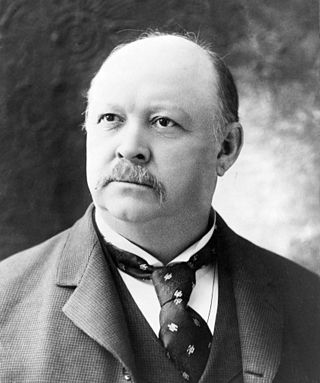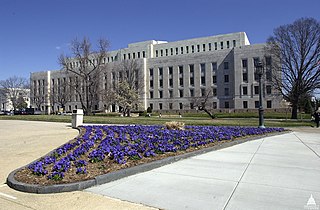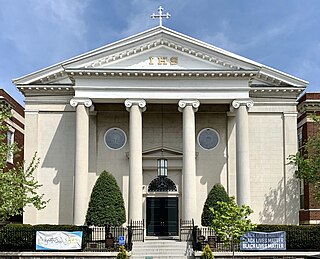
Thomas Brackett Reed Jr. was an American attorney, author, parliamentarian and politician from Maine. A Republican, he served as the U.S. Representative from Maine's 1st congressional district (1877–1899) and as the 32nd Speaker of the United States House of Representatives. Prior to his service in Congress, Reed represented Portland in the Maine House of Representatives and Senate and served as Attorney General of Maine. In 1876, he was elected to represent Cumberland and York counties in the U.S. House and was re-elected for twelve consecutive terms.

Pierre "Peter" Charles L'Enfant was an American-French military engineer who in 1791 designed the basic plan for Washington, D.C., the capital city of the United States. His work is known today as the L'Enfant Plan. He also inspired the street plan for Detroit, Michigan.

The Old Brick Capitol in Washington, D.C., served as the temporary meeting place of the Congress of the United States from 1815 to 1819, while the Capitol Building was rebuilt after the burning of Washington.

Rosslyn is a heavily urbanized unincorporated area in Northern Virginia located in the northeastern corner of Arlington County, Virginia, north of Arlington National Cemetery and directly across the Potomac River from Georgetown and Foggy Bottom in Washington, D.C.

Clarendon is an urbanized, upper-class neighborhood in Arlington County, Virginia, located between the Rosslyn area and the Ballston area. It was named after Edward Hyde, 1st Earl of Clarendon, a leading statesman and historian of the English Civil War. The main thoroughfares are Wilson Boulevard and Clarendon Boulevard.

Carrère and Hastings, the firm of John Merven Carrère and Thomas Hastings, was one of the outstanding American Beaux-Arts architecture firms. Located in New York City, the firm practiced from 1885 until 1929, although Carrère died in an automobile accident in 1911.

The history of Washington, D.C., is tied to its role as the capital of the United States. The site of the District of Columbia along the Potomac River was first selected by President George Washington. The city came under attack during the War of 1812 in an episode known as the Burning of Washington. Upon the government's return to the capital, it had to manage the reconstruction of numerous public buildings, including the White House and the United States Capitol. The McMillan Plan of 1901 helped restore and beautify the downtown core area, including establishing the National Mall, along with numerous monuments and museums.

Arlington House is the historic family residence of Robert E. Lee, commanding general of the Confederate Army during the American Civil War in Arlington County, Virginia. The estate of the historic home along with a memorial to Lee are now the center of Arlington National Cemetery in Arlington County, where they overlook the Potomac River and the National Mall in Washington, D.C.

The Washington metropolitan area, also referred to as the DC area, Greater Washington, the National Capital Region, or locally as the DMV, is the metropolitan area centered around Washington, D.C., the federal capital of the United States. The metropolitan area includes all of Washington, D.C. and parts of Maryland, Virginia, and West Virginia. It is part of the larger Washington–Baltimore combined statistical area, which is the third-largest combined statistical area in the country.

The John Adams Building is the second oldest of the buildings of the Library of Congress of the United States. Built in the 1930s, it is named for John Adams, the second president, who signed the law creating the Library of Congress in 1800. The building is in the Capitol Hill district of Washington D.C. next to the library's main building in the Capitol Complex. The Adams building opened to the public on April 5, 1939, and before being named for the president in 1980, was simply called The Annex building. It is designed in a restrained but very detailed Art Deco style and faced in white Georgia marble. It is located on Second Street SE between Independence Avenue and East Capitol Street in Washington, DC.

Fort Lesley J. McNair is a United States Army post located on the tip of Greenleaf Point, the peninsula that lies at the confluence of the Potomac River and the Anacostia River in Washington, D.C. To the peninsula's west is the Washington Channel, while the Anacostia River is on its south side. Originally named Washington Arsenal, the fort has been an army post for more than 200 years, third in length of service, after the United States Military Academy at West Point and the Carlisle Barracks. The fort is named for General Lesley James McNair, who was killed in action by friendly fire in Normandy, France during World War II.

Jefferson Pier, Jefferson Stone, or the Jefferson Pier Stone, in Washington, D.C., marks the second prime meridian of the United States even though it was never officially recognized, either by presidential proclamation or by a resolution or act of Congress.

The O'Neill House Office Building was a congressional office building located near the United States Capitol at 301 C Street SE in Washington, D.C. Initially known as House Office Building Annex No. 1, it was named after former Speaker of the House Thomas "Tip" O'Neill in 1990.

Holy Trinity Catholic Church is a Catholic church run by the Jesuit order that is located in the Georgetown neighborhood of Washington, D.C., in the United States. Holy Trinity Parish was founded in 1787 and is the oldest Roman Catholic community and house of worship in continuous operation both in Georgetown and in the larger city of Washington, D.C. The original church building was completed in 1794. It is now called the Chapel of St. Ignatius, and is used for smaller ecclesiastical celebrations and as an auxiliary space for parish activities. A larger church building, necessitated by the growing community, was dedicated in 1851, and still serves as the parish church today.

Hawthorne is a neighborhood of 308 single family homes in the Northwest quadrant of Washington, D.C. According to neighborhood lore, the subdivision was named for the hawthorn trees once abundant in the area. The neighborhood borders Montgomery County, Maryland, and is bounded by Pinehurst Tributary to the south, Western Avenue to the northwest, and Rock Creek Park to the east.

The United States Capitol features a dome situated above its rotunda. The dome is 288 feet (88 m) in height and 96 feet (29 m) in diameter. Designed by Thomas U. Walter, the fourth Architect of the Capitol, it was constructed between 1855 and 1866 at a cost of $1,047,291.

Jackson Place is a Washington, D.C. street located across from the White House and forming the western border of Lafayette Square between Pennsylvania Avenue and H Street, NW, beginning just south of Connecticut Avenue. Facing the street are mostly 19th century town homes which are now generally used for government offices of other official functions.

The Twin Bridges Motor Hotel, later known as the Twin Bridges Marriott was the first lodging facility operated by what would become Marriott International. It opened on about January 18, 1957, shortly before the second inauguration of President Dwight D. Eisenhower, and was demolished in 1990.

Walsh-McLean House is a Gilded Age mansion in the Dupont Circle neighborhood of Washington, D.C., located at 2020 Massachusetts Avenue NW. Built in 1901, it is now the Embassy of Indonesia.

The James Tanner Amphitheater is a historic wood and brick amphitheater located at Arlington National Cemetery in Arlington County, Virginia, in the United States. The amphitheater, which was originally unnamed, was constructed in 1873 and served as the cemetery's main public meeting space until the completion of Memorial Amphitheater in 1920. The amphitheater was informally called the Old Amphitheater from 1920 to May 2014, when it was renamed the James R. Tanner Amphitheater in honor of James R. Tanner, a disabled American Civil War veteran and influential veterans' organization leader.




















